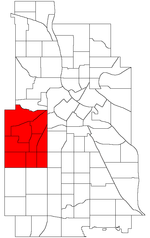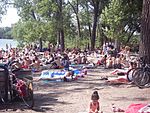Kenwood, Minneapolis
Neighborhoods in MinneapolisTwin Cities, Minnesota geography stubs

Kenwood is a neighborhood within the Calhoun-Isles community in Minneapolis along Lake of the Isles. The neighborhood is one of the most affluent in the city along with the nearby Lowry Hill neighborhood. The Kenwood neighborhood's most notable feature is the many historic mansions along the parkways overlooking the lake and the downtown skyline.Its boundaries are Cedar Lake Parkway to the west, Kenwood Parkway to the north, West Lake of the Isles Parkway to the east, and Kenilworth Place to the south.
Excerpt from the Wikipedia article Kenwood, Minneapolis (License: CC BY-SA 3.0, Authors, Images).Kenwood, Minneapolis
Russell Avenue South, Minneapolis Bde Maka Ska - Isles
Geographical coordinates (GPS) Address Nearby Places Show on map
Geographical coordinates (GPS)
| Latitude | Longitude |
|---|---|
| N 44.959 ° | E -93.3119 ° |
Address
Russell Avenue South 2400
55405 Minneapolis, Bde Maka Ska - Isles
Minnesota, United States
Open on Google Maps










